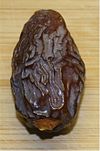
The coconut tree is a member of the palm tree family (Arecaceae) and the only living species of the genus Cocos. The term "coconut" can refer to the whole coconut palm, the seed, or the fruit, which botanically is a drupe, not a nut. The name comes from the old Portuguese word coco, meaning "head" or "skull", after the three indentations on the coconut shell that resemble facial features. They are ubiquitous in coastal tropical regions and are a cultural icon of the tropics.

Phoenix dactylifera, commonly known as the date palm, is a flowering-plant species in the palm family, Arecaceae, cultivated for its edible sweet fruit called dates. The species is widely cultivated across northern Africa, the Middle East, and South Asia, and is naturalized in many tropical and subtropical regions worldwide. P. dactylifera is the type species of genus Phoenix, which contains 12–19 species of wild date palms.

The majhūl date also known as medjool, medjoul, or majhool, is a large, sweet cultivated variety of date originally grown in the Tafilalt region of Morocco, but is currently also grown in the United States, Israel, Palestine, Iran, Saudi Arabia, South Africa, and Jordan. The variety is planted both for its fruit and for landscaping. The medjool is a distinct landrace, described as producing "large soft fruit, with orange-yellowish flesh, and a mildly rich and pleasing flavor". Israel currently holds more than 60 percent of the global mejhoul market share, making it the largest exporter of mejhoul dates in the world.
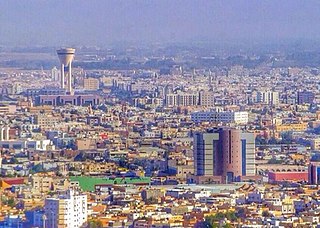
Tabuk is the capital city of the Tabuk Region in northwestern Saudi Arabia. It has a population of 667,000. It is close to the Jordan–Saudi Arabia border and houses the largest air force base in Saudi Arabia.
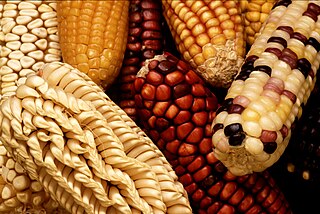
Agricultural biodiversity or agrobiodiversity is a subset of general biodiversity pertaining to agriculture. It can be defined as "the variety and variability of animals, plants and micro-organisms at the genetic, species and ecosystem levels that sustain the ecosystem structures, functions and processes in and around production systems, and that provide food and non-food agricultural products.” It is managed by farmers, pastoralists, fishers and forest dwellers, agrobiodiversity provides stability, adaptability and resilience and constitutes a key element of the livelihood strategies of rural communities throughout the world. Agrobiodiversity is central to sustainable food systems and sustainable diets. The use of agricultural biodiversity can contribute to food security, nutrition security, and livelihood security, and it is critical for climate adaptation and climate mitigation.

Al-Hofuf is the major urban city in the Al-Ahsa Oasis in the Eastern Province of Saudi Arabia, with a population of 858,395. It is also known for being one of the largest date producers in the world, and for its old markets and palaces.

Al-Aḥsāʾ, also known as al-Ḥasāʾ (الْحَسَاء) or Hajar (هَجَر), is an oasis and historical region in eastern Saudi Arabia. Al-Ahsa Governorate, which makes up much of the country's Eastern Province, is named after it. The oasis is located about 60 km (37 mi) inland from the coast of the Persian Gulf. Al-Ahsa Oasis comprises four main cities and 22 villages. The cities include Al-Mubarraz and Al-Hofuf, two of the largest cities in Saudi Arabia.
Fawwaz bin Abdulaziz Al Saud was a senior member of the House of Saud. In 2006, Fawwaz became one of the members of the Allegiance Commission. However, he died on 19 July 2008, some six months after the establishment of the council.

The palm weevil Rhynchophorus ferrugineus is one of two species of snout beetle known as the red palm weevil, Asian palm weevil or sago palm weevil. The adult beetles are relatively large, ranging between 2 and 4 centimetres long, and are usually a rusty red colour—but many colour variants exist and have often been classified as different species. Weevil larvae can excavate holes in the trunks of palm trees up to 1 metre (3.3 ft) long, thereby weakening and eventually killing the host plant. As a result, the weevil is considered a major pest in palm plantations, including the coconut palm, date palm and oil palm.

Neglected and underutilized crops are domesticated plant species used for food, medicine, trading or cultural practices that are significant within their local communities but are not widely commodified or studied as part of mainstream agriculture. Such crops may be in declining production. They are considered underutilized in scientific inquiry for their perceived potential to contribute to knowledge regarding nutrition, food security, genetic resistance, or sustainability. Other terms to describe such crops include minor, orphan, underused, local, traditional, alternative, minor, niche, or underdeveloped.

The Prince Sultan Institute for Environmental, Water and Desert Research is a Saudi Institute was established in 1986 under the name "Center for Desert Studies". It is as an independently administered research organization directly linked to the rector's office of King Saud University. The Institute's purpose is to design and conduct scientific research which is related to desert development and to combating desertification in the Arabian Peninsula.

Plant genetic resources describe the variability within plants that comes from human and natural selection over millennia. Their intrinsic value mainly concerns agricultural crops.

The Southwestern Arabian foothills savanna, also known as the Southwestern Arabian Escarpment shrublands and woodlands, is a desert and xeric shrubland ecoregion of the southern Arabian Peninsula, covering portions of Saudi Arabia, Yemen, and Oman.
Zahidi is a cultivar of the palm date that originated in Iraq. It has light brown skin. It is a semi-dry date of medium size that is very sweet. Zahidi dates ship well and are widely exported.
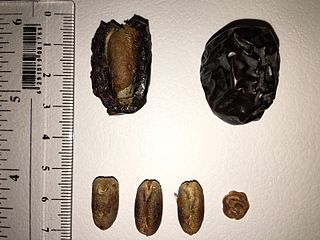
Ajwa is a cultivar of the palm date that is widely grown in Medina, Saudi Arabia. It is an oval-shaped, medium-sized date with black skin. It is often consumed Iftar for Ramadan and other Islamic religious events, since it is traditionally associated with the Islamic prophet Muhammad.
Fard or fardh is a cultivar of the palm date that is widely grown in Oman. It has black skin and small seeds. Fard dates ship well and do not tend to developed wrinkled skin.

Khalas is a cultivar of the palm date that is widely grown in eastern Saudi Arabia and the Persian Gulf region. It has brown skin.
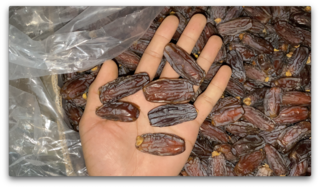
Mabroom is a cultivar of the palm date that is widely grown in Saudi Arabia. It is a large, elongated date similar to the Piarom cultivar.
Rabbi is a cultivar of the palm date that is widely grown in Iran as well as in Pakistan.
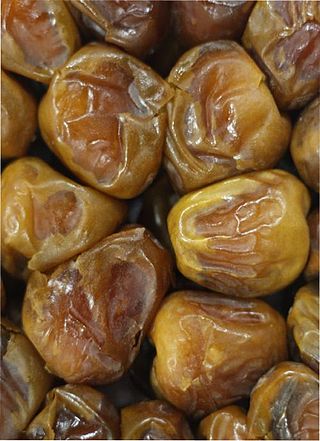
Sukkari or sukkary is a cultivar of the palm date that is widely grown in Saudi Arabia. Its skin is light yellow or golden brown. Sukkari dates are soft and extremely sweet.


















